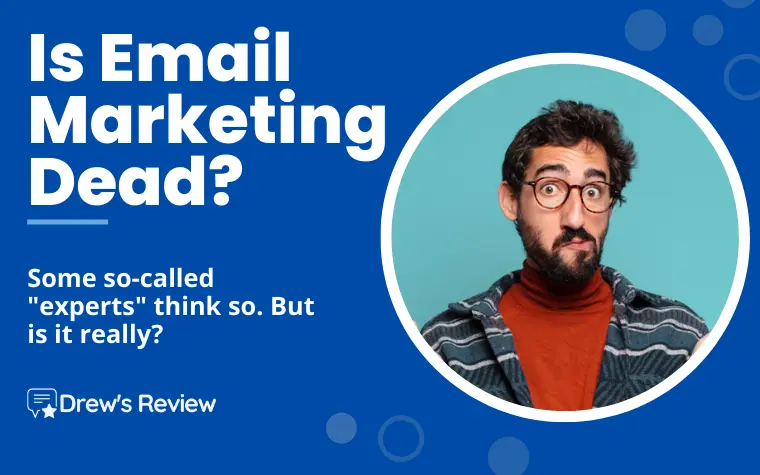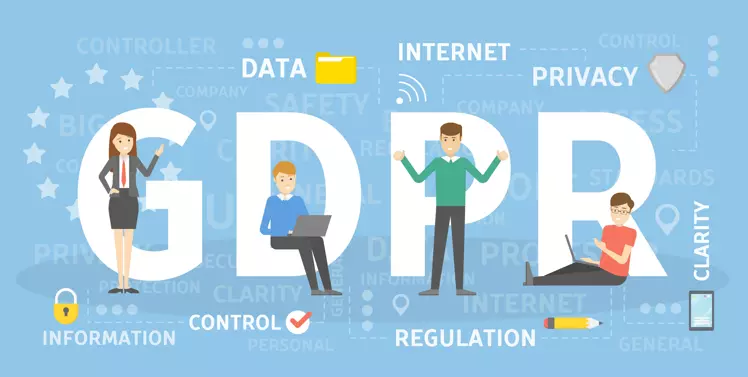
Email marketing has become a key part of every company's strategy. In fact, according to Statista, there are over 4 billion email users daily.
Email marketing is a great way to stay connected with customers and prospects. And since everyone uses email these days, it makes sense to reach out to them through their preferred method.
But despite its popularity, some experts say email marketing might be dying. They claim that companies should focus less on sending emails and instead try other ways to engage with customers.
Furthermore, despite the rise of new social media platforms, 73% of millennialsprefer to receive business communications via email.
On social media platforms, customers expect more content and entertainment.
Why do People Ask, “Is email Marketing Dead?”

Email has been around since the early days of computing. In fact, it’s one of the oldest forms of communication. But over the past few decades, we’ve seen a shift away from traditional mail and toward digital communications.
As a result, there’s been a lot of talk lately about whether email is still relevant. Is it really worth investing in? And what does the future hold for this marketing channel?
The short answer is yes. Email will always be important. People use email every day to communicate with friends and family, send money, book flights, make reservations, buy products, and even vote in elections.
So while some might argue that email is losing relevance, businesses shouldn’t think of it as an afterthought. Instead, they should treat email like a tool — one that they can use to reach customers, build relationships, and increase revenue.
In addition to being useful, email is also effective. A recent study found that emails sent out daily had a much greater chance of getting opened and clicked on compared to those sent weekly.
This makes sense because people tend to check their inboxes multiple times throughout the day. If you want to ensure that your messages get read, you need to make sure they show up in the inbox.
And that brings us to another reason why email will never go away. You see, people don’t just open email; they scan them too. They look at the subject lines, the sender names, and the body copy. They read the headlines and skim the text. All of this helps them decide how to respond.
Email Marketing is Still Relevant
The days of sending out flyers and snail mail are long gone. In fact, according to Forrester Research, email marketing is one of the most effective ways to reach potential customers.
A recent study found that consumers trust email marketing messages more than social media posts, text messages, phone calls, or even TV commercials.
According to the Direct Marketing Association, 72% of people use email regularly. This number includes both personal and professional accounts. So it makes sense that marketers send email to their contacts.
But what about those businesses that don't have a big list? If you're just starting out, you might want to consider buying a mailing list. You'll find lists ranging from $10-$500 per month.
But there's another reason why email marketing continues to be successful. People like receiving information via email. They know how to open it, read it, and respond accordingly. And since email marketing is such a powerful tool, it's easy to see why companies spend millions of dollars each year on it.
What Poor Email Marketing Practices Really Need to Go?
Some things just don't work anymore. Check these out:
1. Not Using GDPR Standards

The General Data Protection Regulation (GDPR), which took effect May 25, 2018, requires businesses to obtain consent from customers before collecting personal data.
This includes information such as name, address, phone number, email address, etc. Businesses must also provide clear and concise privacy policies. They are also prohibited from sending unsolicited email. These requirements apply to both B2C and B2B companies.
Poor email marketing practices include sending out mass email without permission, failing to follow up with recipients about unsubscribed lists, and sending bulk messages to people who haven't opted into your list. All of these things violate GDPR regulations.
2. Impersonal Subject Lines and Content
The average open rate for emails sent to your email lists is around 10%. In fact, according to Open Rates, personalizing email subject lines increases open rates by up to 15%, while personalized text within the body of the email boosts it even further.
Personalization is one of the most effective ways to connect with customers and prospects. If you want to stand out among your competitors, start thinking about how you can make your email campaigns more personable.
For example, you could use the following techniques to craft a compelling subject line:
- Include key words related to the recipient's interests. This way, recipients are less likely to delete your email without reading it.
- Use emoticons to convey emotion. Studies show that people respond better to emojis than plain text.
- Be specific. You don't need to tell everyone what you're sending; let your recipients know why they should care.
- Make sure your email contains useful information. People tend to read longer emails if the content is great, so make sure yours includes enough content to keep readers engaged.
- Avoid long paragraphs and lists. Keep things short and sweet.
3. Not Mobile-Friendly

Mobile-friendliness is one of the most important factors when it comes to getting traffic. If you are not mobile-friendly, you risk losing potential customers.
In fact, according to statistics published by Statista, people use their smartphones more often than desktop computers.
A recent study conducted by Searchmetrics found that 80% of smartphone owners prefer to do searches on their phones rather than on desktops. This trend is expected to continue over the next few years.
So, what does this mean for businesses? They must make sure their sites are mobile-friendly. But how exactly do you know if your site is mobile-ready? Here are two ways to check whether your site is mobile-friendly.
Use the Mobile-Friendly Test Tool
A great way to see if your site is mobile friendly is to use the free tool offered by Google. Simply enter your URL into the box on the left side of the screen. You'll receive a report showing whether your site meets Google's guidelines for mobile friendliness.
Look At Your Analytics
Another easy way to determine whether your site is mobile ready is to look at your analytics. If you're using Google Analytics, there is a section called Device Flow. By clicking on this section, you can view information about mobile devices accessing your site.
4. Not Segmenting Your Lists
Email marketing is one of the most effective ways to reach out to customers and prospects. But it doesn't always work well across different groups of recipients because email messages aren't personalized. If you're sending the same email newsletter message to everyone, you'll lose potential revenue.
Segmenting your list allows you to target specific audiences based on demographic data and behavioral information. You can use this knowledge to personalize each email and increase the likelihood of getting a response.
Here are some examples of how you might segment your lists:
- By gender
- By age group
- Based on location
- Based on interests
5. Poor Email Design

Email design should be fun and engaging to read. In fact, it should be entertaining enough to make you want to open the email and read it. If your emails are boring, people won’t bother opening them.
So how do you make sure your emails are fun and interesting to read? Here are four tips to help you out.
1. Keep it Short
Typically, most people don’t like reading long emails. They prefer shorter ones because they can scan quickly and decide whether they want to continue reading. You can use bullet points to break up the text into smaller chunks. This way, people can easily skim over the important parts without having to spend too much time on each one.
2. Use Images
Images are great tools to engage your audience. They can grab attention and make your subject matter stand out. When designing your emails, think about what type of image works best for your brand. For example, if you sell clothing, you might choose something colorful and eye-catching. On the other hand, if you sell financial products, you could opt for a simple black and white photo.
3. Add Videos
Videos are another effective tool to engage your audience. Videos are easy to watch and digest, which makes them perfect for longer messages. People love watching videos online, especially those that entertain them. Make sure your videos include relevant information and are well-produced.
4. Use a Good Email Marketing Software Tool
Email autoresponders, or email marketing tools as they are more commonly referred to today, are great for helping you design the right emails. For example, if you're a blogger, it's best to send text only emails. If you're a small business owner, you might want to spice it up with images or even videos.
There's a lot of email marketing tools available. Choose one that fits your budget and your needs.
6. Not Strategically Using Metrics
Email marketing is still alive and kicking. But how much time does it take to run a campaign? How often should I send out e-mail? Is there anything else I should know? These questions are common among marketers, especially those who are just starting out. And while some of these questions are easy to answer, others require a little more thought.
Tracking metrics allow you to see which parts are successful or unsuccessful. You can use bounce rates to figure out why someone might unsubscribe. Knowing these things will help make sure you aren’t wasting resources sending irrelevant messages.
You don’t have to wait for reports to come in to find out whether your efforts are working. Analytics tools like GetResponse offer real-time reporting. They show you where your audience is located, how long they spend reading each email, and even how many times they open them. This information helps you understand what works and what doesn’t.

Don’t just mail out willily nilly. Think about whom you want to reach and why. What do you want them to do? Do you want to inform them about upcoming events? Get them to sign up for a newsletter? Make a sale? If you’re unsure, ask yourself these questions before you start sending.
Use analytics to see if people actually read your email. Did they open them? Click through to your site? Buy something? Some platforms provide detailed statistics that show exactly how effective your emails are.
Many autoresponders let you segment your contacts based on specific criteria. You can set up filters that let you target certain groups of people based on age, gender, location, interests, etc. Then, you can send tailored messages to each group. All this will greatly improve your conversion rates.
7. Offering Too Much Information
Email marketing is one of the most effective ways to communicate with customers and prospects. But it’s important to keep things simple and avoid sending too much information. People don't have the attention span to read a long email, so keep it short.
What Are the Best Practices for Ensuring That Your Email Marketing Strategy Is Effective?
The first thing to do is to make sure you have a good list of subscribers. You can use any number of tools, but I recommend using MailChimp because it's free and easy to set up. Once you've got your list, you need to be sure that you're sending relevant content to them on a regular basis. If they don't see anything from you, they'll stop opening your email.
You also need to make sure that you're sending email at the right time. Studies show that people who receive email in the morning are more likely to click through. That's because they're fresh and ready to go when they wake up. On the other hand, people who get email in the evening aren't as likely to open them. It takes them longer to get into the habit of checking their inboxes every day.
And finally, you should always include an unsubscribe link for all of your email users. That way, people will never feel obligated to stay subscribed.
So if you want to reach potential customers, you need to make your email stand out. To do that, you need to focus on three things:
- The subject line
- The body of the email
- The call-to-action (CTA) button
The first thing people see when they open an email is its subject line. It’s what makes or breaks a message. If it doesn’t grab their attention, then they won’t read any further.
That’s why you need to spend so much time crafting great subject lines. According to HubSpot, the average person spends only 3 seconds scanning a subject line before deciding whether to open the message. And once they start reading, they typically take less than 10 seconds to finish.
That means you have very little room for error. Your subject line needs to be compelling enough to pique someone's interest. Otherwise, they may simply delete it without opening it.
Here are seven things you must remember to have a successful Email Marketing Campaign
1. Get personal. The key to making a successful email marketing campaign is to connect with your audience. To do this, you need to share stories about yourself. If you are trying to sell a product or service, tell a story about someone who has used your product or service and how it helped them.
2. Offer solutions. People love talking about problems. And since everyone loves solving problems, you need to offer solutions to their problems.
3. Ask questions. People hate feeling dumb, so asking questions shows that you respect them. Plus, it makes them feel smart.
4. Give testimonials. People love hearing success stories. So whenever possible, include customer reviews.
5. Show proof. Pictures speak louder than words. In fact, studies show that photos are almost twice as effective as text alone.
6. Share stats. Stats help prove your point. And while you may think that sharing too much data will scare away potential customers, research shows that people appreciate being shown data that proves your claims.
7. Create urgency. Urgency is another way to get attention. It is especially important for B2B companies because buyers aren't always ready to purchase immediately. Instead, they prefer to wait until everything is perfect before committing.
Conclusion
In short, email marketing is not dead. I've proven it to you with everything you have read in this article. So if you are thinking about incorporating an email marketing campaign in your business, don't second guess it. Get yourself an autoresponder and start filling those email inboxes!
Just be sure to balance your content with a lot of helpful tips and information. Don't send too many promotional emails and you'll do well.
Comment below with any questions!
Liked this article? Consider sharing!
You might also like...
- Best Ways to Make Passive Income on YouTube - April 15, 2024
- How I Make Faceless YouTube Channels With AI - April 9, 2024
- Top 21 Faceless YouTube Niches to Earn Big Profits in 2024 - April 3, 2024
